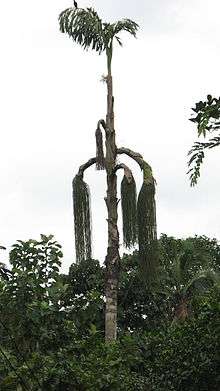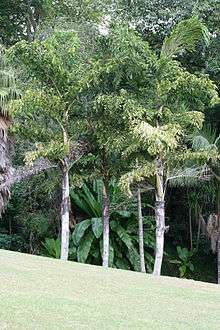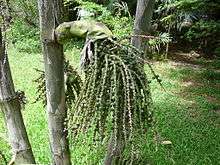Caryota urens
Caryota urens is a species of flowering plant in the palm family, native to Sri Lanka, India, Myanmar and Malaysia (perhaps elswhere in Indo-Malayan region), where they grow in fields and rainforest clearings, it is regarded as introduced in Cambodia.[2][3] The epithet urens is Latin for "stinging" alluding to the chemicals in the fruit. Common names in English include solitary fishtail palm, kitul palm, toddy palm, wine palm, sago palm and jaggery palm.[2] Its leaf is used as fishing rod after trimming the branches of the leaf and drying. According to Monier-Williams, it is called moha-karin ("delusion maker") in Sanskrit. It is one of the sugar palms.
| Caryota urens | |
|---|---|
 | |
| Scientific classification | |
| Kingdom: | Plantae |
| Clade: | Tracheophytes |
| Clade: | Angiosperms |
| Clade: | Monocots |
| Clade: | Commelinids |
| Order: | Arecales |
| Family: | Arecaceae |
| Genus: | Caryota |
| Species: | C. urens |
| Binomial name | |
| Caryota urens | |
Description


Caryota urens species is a solitary-trunked tree that measure up to 15 m (49 ft) in height and up to 30 cm (12 in) wide. Widely spaced leaf-scar rings cover its gray trunk which culminate in a 6 m (20 ft) wide, 6 m tall leaf crown. The bipinnate leaves are triangular in shape, bright to deep green, 3.5 m (11 ft) long, and held on 60 cm (24 in) long petioles. The obdeltoid pinnae are 30 cm long with a pointed edge and a jagged edge.
The 3 m (9.8 ft) long inflorescences emerge at each leaf node, from top to bottom, producing pendent clusters of white, unisexual flowers. The fruit matures to a round, 1 cm (0.39 in) drupe, red in color with one seed. Like all Caryotas, the fruit contains oxalic acid, a skin and membrane irritant. As these plants are monocarpic, the completion of the flower and fruiting process results in the death of the tree.
Uses
This species is called kithul (කිතුල්) in Sri Lanka. It is the source of kithul treacle, a liquid jaggery.[4] Toddy is extracted from the inflorescence, and is considered some what powerful compared to toddy extracted from few other palm trees. Pulp of the fully grown up plant is cut, sun dried, powdered and is edible. It is sweet in taste.[5][6] This powder is considered cool and nutritious in Coastal districts of Karnataka. In Sri Lanka, the powder is mixed with coconut milk and cooked to make Kithul Thalapa (කිතුල් තලප).
Elephants are fed both the leaf and the pulp of this plant.
The leaves possess strong fibres and are used for basketry in Cambodia, where the plant is named tunsaè.[3] The heart of the trunk contains a starch similar to sago, as well the trunk can be used for building. The fruit, when its stiff hairs are removed, is pleasant and sweet to eat, and, as elsewhere, the Cambodians cut the stalks to make sugar, which in turn can be made into wine.
Cultivation
Caryota urens is cultivated as an ornamental tree, and planted in gardens and parks in tropical and sub-tropical climates. It is also used as an interior and houseplant when smaller.
References
| Wikimedia Commons has media related to Caryota urens. |
- Loftus, C. (2000). "Caryota urens". IUCN Red List of Threatened Species. 2000: e.T44393459A44452629. Retrieved 28 March 2020.
- "Caryota urens". Germplasm Resources Information Network (GRIN). Agricultural Research Service (ARS), United States Department of Agriculture (USDA). Retrieved 28 March 2020.
- Pauline Dy Phon (2000). Plants Used In Cambodia/Plantes utilisées au Cambodge. Phnom Penh: Imprimerie Olympic. p. 236.
- SciDev.Net. "Sweet science: Sri Lanka's rural treacle industry". SciDev.Net.
- "Sri Lanka's 'Kithul' Palm Syrup: An Ancient Sweetener In Need Of Saving". NPR.org.
- ""Kithul Syrup Can Be Sri Lanka's Maple Syrup To The World"". 27 April 2015.
Bibliography
- Riffle, Robert L. and Craft, Paul (2003) An Encyclopedia of Cultivated Palms. Portland: Timber Press. ISBN 0-88192-558-6 / ISBN 978-0-88192-558-6 (Page 292)
